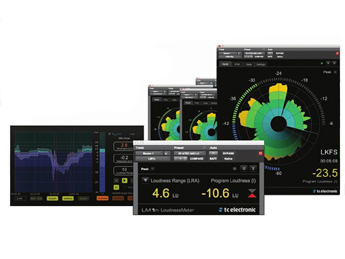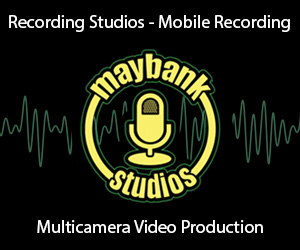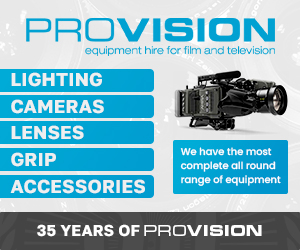Broadcast News
07/10/2014
The File Delivery Revolution...

UK Screen's Neil Hatton explores AS-11 and the DPP's content delivery guidelines. The article below is featured in the HHB Pro Audio Report Issue 2.
2014 will be viewed as a year of huge revolution in post-production. By October 1st, The broadcasters of the Digital Production Partnership (DPP) will be expecting programmes to be delivered as AS-11 files rather than on tapes. They want them to be quality checked and technically certified by an automated device before they are sent. The preferred method of delivery will be over an IP network rather than sending a tape by courier. In addition, the audio will be normalised for loudness rather than peak level by using EBU R128. That's quite some agenda for change within one year.
Moving to files and eliminating videotape allows some significant advances in business processes, as you get rid of the need for manual handling and real-time processes. Files are also less vulnerable to format obsolescence; a big problem for videotape. VTRs are expensive in both capital and maintenance costs. File-based production can take advantage of cheaper commodity IT hardware and outsourced cloud-services such as QC, transcode and storage, assuming that you can afford the bandwidth to get these huge files there. A one-hour AS-11 file weighs-in at close to 50 gigabytes.
In a significant shift from current practice, the broadcasters will stop performing a full technical quality check when receiving programmes. This responsibility for final QC is being pushed back on production companies, and in turn to post-production facilities. Apart from a beginning-middle-end spot-check, the broadcasters will rely on a certificate of technical compliance supplied along with the programme. It's a bold move that is enabled by the use of Automated QC (AQC) software to ensure that programme files are compatible and compliant. As well as all the necessary checks on the file structure and video content, AQC devices will check loudness, maximum true peak level and audio phase, along with a whole range of other audio parameters.
The difficulties of amending programme file masters once they have been encoded means that it is sensible to perform QC as close to the craft suite as possible, so you can easily make amendments. Right now, you can't simply drop-in corrections to an AS-11 file; you have to restart the encoding and QC process from scratch and this takes time. Producers need to get used to this as late changes will be costly and sometimes impossible close to transmission.
The EBU, supported by the DPP have been working hard to define all the possible tests and tolerances that make up the AQC process. However, there are many quality issues that cannot be assessed automatically, either because they are subjective, such as audio intelligibility or because nobody has yet worked out how to measure them on programme material, such as lip sync. A full eyes and ears review is still required to check these and other problems. by doing this in the post-facility and not repeating it at the broadcaster, it will be more efficient and will lead to fewer subjective rejections after delivery.
Some are worried that allowing producers to self-QC will lead to a slide in quality, but the essential thresholds will be kept in check by AQC devices.
Loudness and R128
The transition to R128 loudness has been underway for a while now and will become mandatory for DPP file deliveries. The BBC are actively encouraging dubbing mixers to deliver to R128 even if the programme is on tape. Anecdotal evidence shows that drama mixers are really enjoying the creative freedoms that the increased headroom is bringing, which allows them to create some really dynamic and exciting soundscapes. Entertainment mixers traditionally use a lot of compression and their high-energy balances measure up to 6LU (Loudness Units) above the R128 programme loudness target of -23LUFS (Loudness Units relative to Full Scale). To bring these balances in line with the rest of the broadcasters' evening schedule, sound supervisors are being encouraged to turn up their monitoring levels. If they mix to the sound pressure levels they are used to, this naturally lowers the actual electrical levels of the audio. They can still use lots of compression to achieve that signature sound of say Saturday night entertainment, but it will require overall gain reduction. R128 doesn't stop you using compression as a creative tool, but it cannot be used to be the loudest show on-the-box any more. That's the whole point of loudness normalisation.
Consistent monitoring levels are important for loudness mixing, as now that the meters are in alignment with what you are hearing, you can get back to mixing with your ears, using the meter for confirmation that you are on target. There's a wide choice of meter displays but NUGEN's VisLM plug-in is proving popular. It can be used in Pro Tools, Avid and FCP suites. If you combine this with a normalisation tool like NUGEN's LM-Correct which gives faster than real-time loudness correction, there’s really no excuse not to hit -23LUFS right on-the-nose.
Layback Time (The File Delivery Revolution continued)
If there is going to be no tape to lay the finished audio back to, how do you marry the sound and picture? Generating WAV files from the dubbing suite and laying them back in the online suite has become commonplace and is the easiest solution for AS-11 mastering. It does however mean that the online editor rather than the dubbing mixer becomes the final arbiter of lip sync.
Traditionally the mixer would get to see the on-lined pictures played against the sound track during tape layback, so it is always a good idea to supply a file of the on-lined pictures for the dubbing mixer to check during their final review for substituted shots, duration changes and slippage. However, it is possible to do a layback in the audio suite, by using Neyrinck Soundcode exchange, a plug-in that allows tracks in a Pro Tools session to be substituted into an AS-11 file.
The DPP AS-11 file format disallows Dolby E, requiring surround sound to be placed in the file as six discreet tracks. Whilst this is a simpler approach, there is nowhere to put the Dolby metadata that is needed to control the viewers' set-top box and determine how 5.1 is mixed down for stereo TVs. This is work in progress for the DPP and a new version of their metadata tool is being produced to allow the down-mix metadata to be added as a SMPTE ST436 track within the AS-11 file.
With all this change affecting deliveries to UK broadcasters, it's easy to forget the DPP's AS-11 file is just one deliverable for projects that will probably have several international co-production partners, all with different requirements, possibly including tape.
There's some debate among post-production facilities about whether AS-11 will be used as the file from which everything else is derived, as there is better quality media available in the edit suite timeline. This is resulting in a variety of workflows depending on the size or facility and the scope of the project. And if you think that's not enough, there's the question of who keeps the master file secure for the long-term and how do they do it? Like I said, it's a year of great change with more to come.
Click here to view the full report.
www.hhb.co.uk
(IT/JP)
2014 will be viewed as a year of huge revolution in post-production. By October 1st, The broadcasters of the Digital Production Partnership (DPP) will be expecting programmes to be delivered as AS-11 files rather than on tapes. They want them to be quality checked and technically certified by an automated device before they are sent. The preferred method of delivery will be over an IP network rather than sending a tape by courier. In addition, the audio will be normalised for loudness rather than peak level by using EBU R128. That's quite some agenda for change within one year.
Moving to files and eliminating videotape allows some significant advances in business processes, as you get rid of the need for manual handling and real-time processes. Files are also less vulnerable to format obsolescence; a big problem for videotape. VTRs are expensive in both capital and maintenance costs. File-based production can take advantage of cheaper commodity IT hardware and outsourced cloud-services such as QC, transcode and storage, assuming that you can afford the bandwidth to get these huge files there. A one-hour AS-11 file weighs-in at close to 50 gigabytes.
In a significant shift from current practice, the broadcasters will stop performing a full technical quality check when receiving programmes. This responsibility for final QC is being pushed back on production companies, and in turn to post-production facilities. Apart from a beginning-middle-end spot-check, the broadcasters will rely on a certificate of technical compliance supplied along with the programme. It's a bold move that is enabled by the use of Automated QC (AQC) software to ensure that programme files are compatible and compliant. As well as all the necessary checks on the file structure and video content, AQC devices will check loudness, maximum true peak level and audio phase, along with a whole range of other audio parameters.
The difficulties of amending programme file masters once they have been encoded means that it is sensible to perform QC as close to the craft suite as possible, so you can easily make amendments. Right now, you can't simply drop-in corrections to an AS-11 file; you have to restart the encoding and QC process from scratch and this takes time. Producers need to get used to this as late changes will be costly and sometimes impossible close to transmission.
The EBU, supported by the DPP have been working hard to define all the possible tests and tolerances that make up the AQC process. However, there are many quality issues that cannot be assessed automatically, either because they are subjective, such as audio intelligibility or because nobody has yet worked out how to measure them on programme material, such as lip sync. A full eyes and ears review is still required to check these and other problems. by doing this in the post-facility and not repeating it at the broadcaster, it will be more efficient and will lead to fewer subjective rejections after delivery.
Some are worried that allowing producers to self-QC will lead to a slide in quality, but the essential thresholds will be kept in check by AQC devices.
Loudness and R128
The transition to R128 loudness has been underway for a while now and will become mandatory for DPP file deliveries. The BBC are actively encouraging dubbing mixers to deliver to R128 even if the programme is on tape. Anecdotal evidence shows that drama mixers are really enjoying the creative freedoms that the increased headroom is bringing, which allows them to create some really dynamic and exciting soundscapes. Entertainment mixers traditionally use a lot of compression and their high-energy balances measure up to 6LU (Loudness Units) above the R128 programme loudness target of -23LUFS (Loudness Units relative to Full Scale). To bring these balances in line with the rest of the broadcasters' evening schedule, sound supervisors are being encouraged to turn up their monitoring levels. If they mix to the sound pressure levels they are used to, this naturally lowers the actual electrical levels of the audio. They can still use lots of compression to achieve that signature sound of say Saturday night entertainment, but it will require overall gain reduction. R128 doesn't stop you using compression as a creative tool, but it cannot be used to be the loudest show on-the-box any more. That's the whole point of loudness normalisation.
Consistent monitoring levels are important for loudness mixing, as now that the meters are in alignment with what you are hearing, you can get back to mixing with your ears, using the meter for confirmation that you are on target. There's a wide choice of meter displays but NUGEN's VisLM plug-in is proving popular. It can be used in Pro Tools, Avid and FCP suites. If you combine this with a normalisation tool like NUGEN's LM-Correct which gives faster than real-time loudness correction, there’s really no excuse not to hit -23LUFS right on-the-nose.
Layback Time (The File Delivery Revolution continued)
If there is going to be no tape to lay the finished audio back to, how do you marry the sound and picture? Generating WAV files from the dubbing suite and laying them back in the online suite has become commonplace and is the easiest solution for AS-11 mastering. It does however mean that the online editor rather than the dubbing mixer becomes the final arbiter of lip sync.
Traditionally the mixer would get to see the on-lined pictures played against the sound track during tape layback, so it is always a good idea to supply a file of the on-lined pictures for the dubbing mixer to check during their final review for substituted shots, duration changes and slippage. However, it is possible to do a layback in the audio suite, by using Neyrinck Soundcode exchange, a plug-in that allows tracks in a Pro Tools session to be substituted into an AS-11 file.
The DPP AS-11 file format disallows Dolby E, requiring surround sound to be placed in the file as six discreet tracks. Whilst this is a simpler approach, there is nowhere to put the Dolby metadata that is needed to control the viewers' set-top box and determine how 5.1 is mixed down for stereo TVs. This is work in progress for the DPP and a new version of their metadata tool is being produced to allow the down-mix metadata to be added as a SMPTE ST436 track within the AS-11 file.
With all this change affecting deliveries to UK broadcasters, it's easy to forget the DPP's AS-11 file is just one deliverable for projects that will probably have several international co-production partners, all with different requirements, possibly including tape.
There's some debate among post-production facilities about whether AS-11 will be used as the file from which everything else is derived, as there is better quality media available in the edit suite timeline. This is resulting in a variety of workflows depending on the size or facility and the scope of the project. And if you think that's not enough, there's the question of who keeps the master file secure for the long-term and how do they do it? Like I said, it's a year of great change with more to come.
Click here to view the full report.
www.hhb.co.uk
(IT/JP)
Top Related Stories
Click here for the latest broadcast news stories.
28/01/2013
NUGEN Audio At BVE 2013
At BVE 2013, NUGEN Audio will showcase its complete line of industry-leading solutions for loudness correction that offer a smarter approach to meetin
NUGEN Audio At BVE 2013
At BVE 2013, NUGEN Audio will showcase its complete line of industry-leading solutions for loudness correction that offer a smarter approach to meetin
24/01/2013
NUGEN Audio At BVE 2013
At BVE 2013, NUGEN Audio will showcase its complete line of industry-leading solutions for loudness correction that offer a smarter approach to meetin
NUGEN Audio At BVE 2013
At BVE 2013, NUGEN Audio will showcase its complete line of industry-leading solutions for loudness correction that offer a smarter approach to meetin
19/07/2012
Jünger Audio Makes Audio Loudness Its Focus At BIRTV 2012
Dynamics specialist Jünger Audio will focus on controlling audio loudness in the broadcast chain at this year’s BIRTV convention in China (August 22nd
Jünger Audio Makes Audio Loudness Its Focus At BIRTV 2012
Dynamics specialist Jünger Audio will focus on controlling audio loudness in the broadcast chain at this year’s BIRTV convention in China (August 22nd
14/05/2012
Jünger Audio Makes Audio Loudness Its Focus At Broadcast Asia 2012
Dynamics specialist Jünger Audio will focus on controlling audio loudness in the broadcast chain at this year’s Broadcast Asia convention in Singapore
Jünger Audio Makes Audio Loudness Its Focus At Broadcast Asia 2012
Dynamics specialist Jünger Audio will focus on controlling audio loudness in the broadcast chain at this year’s Broadcast Asia convention in Singapore
04/08/2009
HHB Focuses On 5.1 File-Based Audio Production At IBC
The venue for a number of new product announcements, the HHB stand at IBC 8.E54 is prominently located at the entrance to Hall 8 and provides a unique
HHB Focuses On 5.1 File-Based Audio Production At IBC
The venue for a number of new product announcements, the HHB stand at IBC 8.E54 is prominently located at the entrance to Hall 8 and provides a unique
16/09/2004
NTI Dragon Burn now supports leading image & audio file formats
In addition to fine-tuning the DVD Video burning capabilities of Dragon Burn, NTI has now added Mac Panther compatibility and support for virtually al
NTI Dragon Burn now supports leading image & audio file formats
In addition to fine-tuning the DVD Video burning capabilities of Dragon Burn, NTI has now added Mac Panther compatibility and support for virtually al
05/02/2014
NUGEN Audio Prepares For BVE 2014
NUGEN Audio is to showcase a range of its products, including the new MultiMonitor software for loudness and true-peak monitoring, at this year's BVE
NUGEN Audio Prepares For BVE 2014
NUGEN Audio is to showcase a range of its products, including the new MultiMonitor software for loudness and true-peak monitoring, at this year's BVE
02/10/2014
DPP To Test File-Based Analyser Devices
The Digital Production Partnership (DPP) has announced plans for the testing and certification of File Based Analyser devices. The move comes as the D
DPP To Test File-Based Analyser Devices
The Digital Production Partnership (DPP) has announced plans for the testing and certification of File Based Analyser devices. The move comes as the D
13/10/2017
DPP Updates 'A Producer's Guide To File Delivery'
The Digital Production Partnership (DPP) has published an updated version of A Producer's Guide to File Delivery. Enabled by DPP Member, Deluxe Entert
DPP Updates 'A Producer's Guide To File Delivery'
The Digital Production Partnership (DPP) has published an updated version of A Producer's Guide to File Delivery. Enabled by DPP Member, Deluxe Entert
03/07/2015
Turning Up The Volume
Picking up from Issue 225, we're once again looking at Broadcast Audio, particularly at loudness metering and mixing consoles – and how the industry i
Turning Up The Volume
Picking up from Issue 225, we're once again looking at Broadcast Audio, particularly at loudness metering and mixing consoles – and how the industry i
24/07/2012
NUGEN Audio Launches LMB 1.4
NUGEN Audio, creator of intuitive tools for audio professionals, has expanded its range of groundbreaking loudness correction tools with the release o
NUGEN Audio Launches LMB 1.4
NUGEN Audio, creator of intuitive tools for audio professionals, has expanded its range of groundbreaking loudness correction tools with the release o
26/03/2014
NUGEN Audio To Unveil Complete Family Of Solutions At NAB 2014
With a special emphasis on the emerging loudness requirements of American broadcasters, NUGEN Audio is presenting its complete family of industry-lead
NUGEN Audio To Unveil Complete Family Of Solutions At NAB 2014
With a special emphasis on the emerging loudness requirements of American broadcasters, NUGEN Audio is presenting its complete family of industry-lead
04/10/2013
ZEN And The Art Of Loudness Metering
Television loudness has been a viewer’s concern for decades, but recent ITU standardisation has focussed the attention of programme creators on achiev
ZEN And The Art Of Loudness Metering
Television loudness has been a viewer’s concern for decades, but recent ITU standardisation has focussed the attention of programme creators on achiev
10/04/2015
NUGEN Audio Releases Loudness Toolkit 2
NUGEN Audio has released Loudness Toolkit 2, the latest generation of the company's suite of loudness metering and correction tools. Consisting of the
NUGEN Audio Releases Loudness Toolkit 2
NUGEN Audio has released Loudness Toolkit 2, the latest generation of the company's suite of loudness metering and correction tools. Consisting of the
11/11/2016
What Is The Future For Immersive Audio?
Peter Poers, Managing Director at Jünger Audio, looks at production efforts versus consumer experience. Introduction Along with the evolution of highe
What Is The Future For Immersive Audio?
Peter Poers, Managing Director at Jünger Audio, looks at production efforts versus consumer experience. Introduction Along with the evolution of highe















